Episode 168 Show Notes
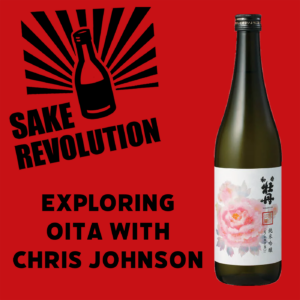 Episode 168. We are off to explore the sake scene in another region of Japan! This time it is beautiful Oita Prefecture! As we don’t know much about Oita, despite there being 33 sake breweries there, we needed to phone-a-friend. Luckily for us, our buddy Chris Johnson (aka The Sake Ninja) lived for 3 years in rural Oita on the Jet program. Chris gets us up to speed on the charms of Oita as well as the local customs and food culture. We also hear tales of Onsen that are so hot, they known as the Seven Hells as well has compulsory sumo wresting and a drinking game or two thrown in for good measure. We also taste Wakabotan sake, a newly exported Oita brew. Let’s explore together what Oita has to offer! #SakeRevolution
Episode 168. We are off to explore the sake scene in another region of Japan! This time it is beautiful Oita Prefecture! As we don’t know much about Oita, despite there being 33 sake breweries there, we needed to phone-a-friend. Luckily for us, our buddy Chris Johnson (aka The Sake Ninja) lived for 3 years in rural Oita on the Jet program. Chris gets us up to speed on the charms of Oita as well as the local customs and food culture. We also hear tales of Onsen that are so hot, they known as the Seven Hells as well has compulsory sumo wresting and a drinking game or two thrown in for good measure. We also taste Wakabotan sake, a newly exported Oita brew. Let’s explore together what Oita has to offer! #SakeRevolution
Skip to: 00:19 Show Opening
Welcome to the show from John and Timothy
Skip to: 01:32 Exploring Oita with Chris Johnson
Where is Oita?
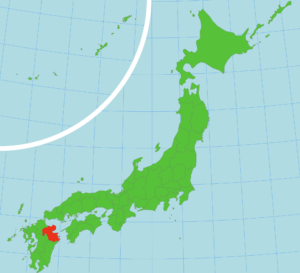 About Oita via Wikipedia: “Ōita Prefecture (大分県, Ōita-ken) is a prefecture of Japan located on the island of Kyūshū. Ōita Prefecture borders Fukuoka Prefecture to the northwest, Kumamoto Prefecture to the southwest, and Miyazaki Prefecture to the south. Ōita is the capital and largest city of Ōita Prefecture, with other major cities including Beppu, Nakatsu, and Saiki.Ōita Prefecture is located in the northeast of Kyūshū on the Bungo Channel, connecting the Pacific Ocean and Seto Inland Sea, across from Ehime Prefecture on the island of Shikoku. Ōita Prefecture is famous for its hot springs and is a popular tourist destination in Japan for its onsens and ryokans, particularly in and around the city of Beppu.”
About Oita via Wikipedia: “Ōita Prefecture (大分県, Ōita-ken) is a prefecture of Japan located on the island of Kyūshū. Ōita Prefecture borders Fukuoka Prefecture to the northwest, Kumamoto Prefecture to the southwest, and Miyazaki Prefecture to the south. Ōita is the capital and largest city of Ōita Prefecture, with other major cities including Beppu, Nakatsu, and Saiki.Ōita Prefecture is located in the northeast of Kyūshū on the Bungo Channel, connecting the Pacific Ocean and Seto Inland Sea, across from Ehime Prefecture on the island of Shikoku. Ōita Prefecture is famous for its hot springs and is a popular tourist destination in Japan for its onsens and ryokans, particularly in and around the city of Beppu.”
About Chris Johnson
 Chris Johnson is a Sake Samurai, nihonshu nut, food fanatic and wine worshiper.
Chris Johnson is a Sake Samurai, nihonshu nut, food fanatic and wine worshiper.
Saké Educator, Consultant and THE SAKE NINJA ®
Instagram: https://www.instagram.com/thesakeninja
Chris Johnson’s Experience in Oita on the Jet Program
Chris was on the Jet program in Oita prefecture for 3 years. You can learn about this program here: https://oitajets.weebly.com/
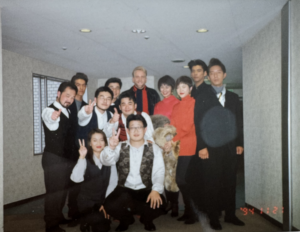
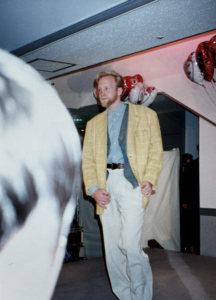
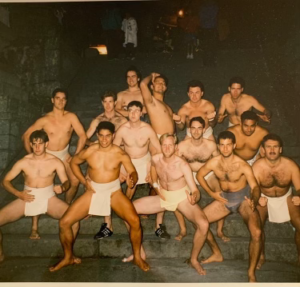
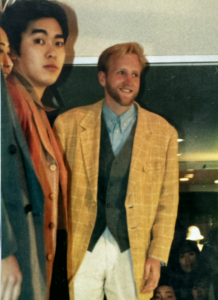
Skip to: 17:52 Sake Tasting: Wakabotan Hinohikari Junmai Ginjo
Wakabotan Hinohikari Junmai Ginjo
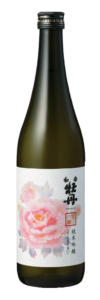
Brewery: Sanwa Shurui
Classification: Junmai Ginjo
Alcohol: 14.5%
Prefecture: Oita
Seimaibuai: 50%
SMV: ±0
RICE: Hinohikari
Yeast: Kyokai 1801
Acidity: 1.9
Brand: Wakabotan
Importer/Distributor: Mutual Trading (USA)
Skip to: 29:57 Show Closing
This is it! Join us next time for another episode of Sake Revolution!
Announcing Patreon
 Now there is a new way to support Sake Revolution. Join us on Patreon! Patreon is an online platform that allows you to support your favorite creators by subscribing to a monthly membership. At Sake Revolution, we’re offering two tiers, each with its own perk. If you enjoy our sake podcast, if you are able, please consider supporting this labor of sake love! See below to learn about our Patreon support levels.
Now there is a new way to support Sake Revolution. Join us on Patreon! Patreon is an online platform that allows you to support your favorite creators by subscribing to a monthly membership. At Sake Revolution, we’re offering two tiers, each with its own perk. If you enjoy our sake podcast, if you are able, please consider supporting this labor of sake love! See below to learn about our Patreon support levels.
-
Sake Enthusiast
Have you ever wanted to sip along with us as we taste our sakes on the podcast? Now you can! As a Sake Enthusiast patron, you’ll get the inside track and know in advance which sakes we’ll be featuring on the show. This allows you to get them on hand and sip along with us while you listen.
-
Sake Otaku
As a Sake Otaku supporter of the pod, you’ll get access to all the Sake Enthusiast intel along with access to a monthly live zoom Sake Happy Hour taking place the first Weds of every month at 9pm ET (6pm PT). Visit with us live on zoom! Come with all your questions and suggestions and enjoy a relaxed and fun Happy Hour with with us as we all sip sake together!
Episode 168 Transcript
John Puma: 0:21
And welcome to Sake Revolution. This is America’s first sake podcast. If you’re new here, I am your host John Puma from the Sake Notes as also the administrator at the internet sake discord and reddit’s r slash sake community.
Timothy Sullivan: 0:34
And I’m your host, Timothy Sullivan. I’m a Sake Samurai. I’m the Director of Education at the Sake Studies Center, and I’m also the founder of the Urban Sake website. And every week, John and I will be here tasting and chatting about all things sake, And doing our best to make it fun and easy to understand.
John Puma: 0:51
Tim you adjusted your intro a little bit. I like that
Timothy Sullivan: 0:54
a little.
John Puma: 0:55
You know as as the as the resume changes so must or as the resume gathers new new items So must the intro change
Timothy Sullivan: 1:03
And you, you know, I don’t like to change my script, right?
John Puma: 1:06
No, no, you don’t like to change your script at all. That must have been, uh, that must have caused crippling anxiety for you.
Timothy Sullivan: 1:13
We got through it together.
John Puma: 1:15
Oh, nice. So how are things? Good.
Timothy Sullivan: 1:17
Things are good. And I’m excited for today. We’re going to be talking about a place in Japan. I pretty much know nothing about, so that’s good.
John Puma: 1:28
Well, it’s a place in Japan I know very little about. So that works out.
Timothy Sullivan: 1:32
are we going to talk about today?
John Puma: 1:34
Uh, today we’re going to talk about, uh, OITA a prefecture.
Timothy Sullivan: 1:38
Ooh, a Prefecture profile. I
John Puma: 1:39
yeah, we’re gonna, we’re gonna do a, we, what we call them the, prefecture deep dive, but not too deep
Timothy Sullivan: 1:45
Not too deep.
John Puma: 1:46
because neither of us have spent an appreciable amount of time there. I was there for a whopping two days last year. So I think that my own ability to speak with authority, uh, might be limited. How about you?
Timothy Sullivan: 1:59
Oh, I, I don’t know much about OITA at all. I think, I think we’re going to need to phone a friend on this one.
John Puma: 2:06
All right. Do we have one handy?
Timothy Sullivan: 2:08
We do!
John Puma: 2:09
Ah,
Timothy Sullivan: 2:11
Let me introduce our good buddy and Sake Revolution alumni, Chris Johnson. Uh, he is the National Sales Manager for World Sake Imports. And also World renowned as the Sake Ninja, Chris first appeared on Sake Revolution in May of 2020 in episode eight, back when we didn’t know what we were doing and we still don’t. And,
John Puma: 2:35
say I quit it. What changed?
Timothy Sullivan: 2:37
and CJ was also a very special guest on our 100th episode in March, 2022. So with that, let’s welcome CJ, Chris Johnson to the episode. Hey, Chris.
Chris Johnson: 2:48
Hello, hello. Very excited to be joining you again for this exciting opportunity.
John Puma: 2:54
Yeah,
Chris Johnson: 2:55
Should be fun to go down the path of Oita ken and its exciting stories. I don’t know if I know all the history. but I do personally have quite a bit of history in the prefecture.
John Puma: 3:09
have plenty of history there. So can you, uh, tell our, our listeners what your history entails?
Chris Johnson: 3:16
Well, I was on a program called the JET program. Which is an exchange and teaching program set up by the Japanese government. And I, like almost everyone who applies, said, I want to be in the countryside of Kyoto. And all I think they heard was countryside, cause I ended up in the countryside of Oita Ken. And I lived there for, I lived there for three years and dug in and loved all of it and pretty much did anything you could imagine when it came to Oita and its existence, so pretty fun.
Timothy Sullivan: 3:47
Can I ask you, what was your first thought when you opened the letter and it said you’re going to Oita Prefecture?
Chris Johnson: 3:55
I mean, keeping it PG, it was where the, is that place?
Timothy Sullivan: 4:02
Did you reach for a map right away?
Chris Johnson: 4:04
I went, I went and immediately searched for a map and it, you know, I, because we’re old, we didn’t have these things called cell phones at the time, so I couldn’t just quickly Google it. I had to, you know, sit down and try and figure out where this place was. I actually also phoned a friend, uh, and asked a family friend who lived in Tokyo, I was like, talk to me about this Oita Kusumachi place, and they went, we know nothing, was their response.
John Puma: 4:31
so for, uh, for everybody at home, uh, Oita is, um, located in Kyushu. So on, uh, Kyushu Island and then like, uh, Southern Japan. And it’s, it’s on the, it’s pretty much the, the Eastern most part of the island. If I’m, if I’m not horribly mistaken, is
Chris Johnson: 4:44
Northeast, kept me in the Northeast, just, it was a different part of the Northeast.
Timothy Sullivan: 4:51
So Chris, can you give us the cliff notes version of Oita? Like, what is it famous for? What should people know about it?
Chris Johnson: 4:59
So, it’s famous for quite a few things, actually, but, uh, one of the main things is that it is heavy, uh, the onsen, quote unquote, onsen capital of the world, Beppu, is right there in Oita, where they have the seven pools of hell. Uh, don’t know if that sounds as attractive as I just made it sound, but it’s, it’s, it’s what they call it.
John Puma: 5:22
I need, we need to rewind. Uh, uh, Seven Pools of Hell,
Chris Johnson: 5:26
Yes, uh, yes, because they’re all,
John Puma: 5:28
it,
Chris Johnson: 5:28
yeah, the hot springs, they have different, take a path up to all the different experiences. One’s blue, one’s red. It’s fairly exciting, but yeah, they’re To me, when I always went to it, I felt like Beppu was the Vegas of Onsen, because I had lived out in the countryside. So when I first learned about hot springs, it was like actual, like outdoor or a little bit more, you went into this old hut in this old house and all these, you know, the wonderful aspects of what we’ve come to know is ryokan and onsen. And in Beppu, it’s big flashing lights and gigantic pools and neon signs and all sorts of fun things like that. So that’s one of the things that’s quite well known for. It is also known for. Shimesaba, and the actually amazing mackerel that is there. They have great blowfish. And nature, right, so that’s another thing that’s very much so a component of Oita. beautiful changing of leaves in the town I lived in. There used to be a road not that far down the The street from where I live that people would drive from hours away just to sit and traffic. That’s literally a 20 minute drive that would take them four hours to get through just to see the different colors of leaves in this one area.
John Puma: 6:45
Oh,
Chris Johnson: 6:46
So lots of fun. Oita is also known for its One of the few places historically that made both shochu, because that’s a Kyushu thing, as well as sake, because we had just enough cold weather and, and good snow melt to be able to create fantastic sake.
Timothy Sullivan: 7:02
could you give us a quick Uh, differentiation between what shochu is versus what sake is for our listeners who may not be familiar.
Chris Johnson: 7:10
Sure. Well, I’m pretty sure you all know what sake is based on the number of episodes
Timothy Sullivan: 7:15
Ha ha
Chris Johnson: 7:16
to by these two fantastic gentlemen. But the big difference between the two is that shochu is our distilled spirit. Uh, and it can be made from multiple different bases. It’s pretty much anything that has starch and or naturally occurring sugar can become a shochu. The one thing that gives a parallel between the two is that both of them must use koji. So the difference being that it’s a ferment like sake that then can become an alcohol once it’s distilled, so we do have shochus that have been made from a sake base, but you can make from carrots and brown sugar and sweet potato and other potatoes and barley and grains and all sorts of fun things, so it’s very different, but Intriguing that we had both in the same area. And so I got to experience both of those items quite often as a young individual venturing into the world of Japanese culture when I first went there to teach English. And to understand how far in the countryside I was, when we got picked up from the plane flying down from our orientation in Tokyo, all the other. New jets got sweeped away into Oita City for a meeting and a couple more days of getting to know each other. I got picked up by two people that did not speak English, and then they drove me to my town. And two and a half hours later, after driving through mountains and tunnels and valleys and more mountains and more tunnels and more valleys, and it just got farther and farther into the countryside, and then they were like, We’re here! that’s where I lived.
John Puma: 8:49
Mountains and tunnels are making me think that they figured you were a flight risk and they had to prevent it.
Chris Johnson: 8:53
they wanted to make sure I got stuck in the town and I couldn’t get out.
John Puma: 9:00
That’s interesting. I didn’t see that coming. and then you said you were over there for, uh, what, three years
Chris Johnson: 9:05
Yes, three years. I went for a one year contract and then just kind of fell in love with the situation and didn’t think I was done with doing what I was there to do, which was to get everybody to know me as Chris instead of Gaijin and, you know, the barbarian foreigner, as some of you have all gotten to notice from the Shogun, uh, recent production that was out there, uh, so that that I felt that the year three was when I finally had accomplished said goals. I was just another human who drank a lot of sake when I lived there.
John Puma: 9:34
So you were introduced to sake when you were
Chris Johnson: 9:35
I was. Uh, however, introduction is very different than under in the sense of I was introduced to it, but I wasn’t introduced to what sake is today and what we all understand of the Daiginjos and Ginjos. I was drinking beautifully made sake, but it was at office parties. And I was often invited to every office party. And so part of that culture was to share a drink with your co workers and have as many drinks as your superior or senpai wants you to partake in. So there was just a lot of me wandering around circles of 20 plus individuals at a party and just sitting and drinking with all of them. And we drank again, perfectly wonderful sake, but it was all futsushu. So I did not know the quality of things that were out there until I, I Basically left in the third year right before I left, I got exposed to some beautiful stuff.
Timothy Sullivan: 10:31
Yeah, yeah. Tell us that story. That’s, that’s your aha moment was right when you were on the way out.
Chris Johnson: 10:37
on the, on the way out there, you’re getting rid of
Timothy Sullivan: 10:40
happened? What happened?
Chris Johnson: 10:42
again, after years of drinking sake, I didn’t despise it in any way, shape, or form, but it was just a beverage that got us to the next stage of the evening, right? Start with sake, go to beer, end up in some sort of other Other space, depending on how many kais we had. Ichijikai, Nijikai, Sanjikai, Yonjikai, all those fun numbers of parties as you build through them. We, we had gotten to year three. I was leaving. I was at my farewell party and had a whole bunch of people there. It was a big celebration and they brought me a beautiful, big 1. 8 liter sake wrapped in a gigantic box. with bows, and it was wood, and it was a Junmai Daiginjo from Yatsushika Shuzo, which is a a brewery just in the next town where I lived, also in Oita. And I looked at it and I went, sake. I’ve just packed up three years of stuff. And every school that I taught at, I taught at seven schools, everybody gave me letters and pictures and items. So there was just, I’d already packed a lot and I’m like, how am I going to fit this ginormous 1. 8 liter in a box back home with me? And I’m on stage at the point and my mom’s, Little voice jumps in my head and says, this is such a wonderful gift. We should share it with everybody. And so I was like, this is so great. We should all do it. Let’s all pour out a Kanpai. I said a little speech, took a sip of the sake. It was like, don’t finish it. Give me some of that back. Cause it was absolutely amazing. And I was like, Oh, wow. I need to learn more about this beverage. And I left three days later and started my path, true path of sake back here in the United States.
John Puma: 12:20
Nice.
Timothy Sullivan: 12:21
So when you landed back in the States, like echoes of that delicious flavor were lingering in your, in your mind, and you’re like, I got to study more about that
Chris Johnson: 12:29
Exactly. And then started a job about two weeks after I got home at a small restaurant in midtown called Katsuhama. They had five sakes on their list, and that was the beginning of the tour of just tasting and experiencing and kept going from 1996 all the way till today.
Timothy Sullivan: 12:48
you’re known as the sake ninja. But I understand you also had a few experiences you in Oita where perhaps you could have wound up as the sake sumo wrestler.
Chris Johnson: 12:59
Yeah. There’s the, this is, this is very true. There are, there is this fact that I was, I did sumo wrestle and I did drink sake on the same evening, so I could have beca become the sake sumo. Samurai, something, I don’t know, we’ll figure out what it is Yeah, so
Timothy Sullivan: 13:16
you doing? How did that happen? Why were you doing sumo wrestling? How did that
Chris Johnson: 13:21
one of the many traditions in the small town that I lived in, uh, and is that when you join the town office every year, the first year members of the town office must participate in a 300 plus year old sumo tournament in one of the small little villages that are part of the overall town. And. I met two people on the first day that I rolled into the office, and they came up to me in their best English, and I did not speak Japanese at the time, and they said, Chris, you like sumo? And I said, yes, I don’t really know what sumo is, but of course, of course I love it. It’s fantastic. Those are big guys that push each other around, right? Yeah, sure, I love it. Did not see those two guys until Again, this was in the end of August, or end of July, I guess. I didn’t see those two individuals again until October 29th. And they came in and they handed me a little blue book, which is what they do in Japan, the little blue books, and now I could read my name. And I saw my name and they said, Sumo tournament, Kusan, sub captain, practice tonight. And the tournament was the 31st every year. And so I went in and, and practiced that night, uh, learning how to be a sumo wrestler per se. And those of you who might know me, uh, I am a lot heavier than I was when I lived in Japan. And so I was probably 175, 180 pounds, uh, sweaty and soaking wet. And they put me into these
Timothy Sullivan: 14:54
like six, two,
Chris Johnson: 14:55
Six, Six, foot one. Yeah, so a fairly tall person and a very skinny one. And so the sumo was a, was an interesting yet, yet fantastic event, but it was super fun. It was amazing. Um, I can tell you that when you’re not a pro, the little Mawashi, which are the Kind of outfits you wear are made out of canvas, and they’re nowhere near as comfortable as one might think they’d be. I know they look very comfortable when you see them on TV, but they’re not. Um, and we wrestled, we did it, and I was, had so much fun. I laughed, I called friends, and then I, for the next two years, I invited foreigners, and we had a foreigner team. And then the third year, we had two foreigner teams come in and actually participate in this tournament. Uh, and it was, it was hilarious. It was absolutely hilarious. I have a photo somewhere of me against my very first, uh, opponent and this is, he’s probably in junior high school, but he’s 265 pounds on his way to go to Tokyo to be a part of an actual sumo beya. Like, he was becoming a sumo wrestler and that was the first person that I ever fought, uh, in an actual sumo ring. And I kind of remember the guy saying go and then I looked up and I was on my back outside the ring. So, um, that was fun.
Timothy Sullivan: 16:19
Well, if we can locate that picture, we have to
Chris Johnson: 16:22
Oh,
Timothy Sullivan: 16:22
it in the show notes.
John Puma: 16:23
uh,
Chris Johnson: 16:23
have it somewhere.
John Puma: 16:25
show notes.
Chris Johnson: 16:27
I have it somewhere. I just have to find it.
John Puma: 16:28
Yeah.
Chris Johnson: 16:29
so sumo was a, was very exciting, I did get to participate in pretty much every sport you could imagine that ever happened in that town. Um, so another exciting sake related tradition was that on the baseball team, the same rookies would have to drink out of a 1. 8 liter bottle as much as they can. Right? To show how much they can participate in the alcohol situation. I do not recommend this to all you listeners out there. This is not something you should go and try and do on your weekends. However, I did participate in said thing. And I will tell you, uh, that I drank too much of that bottle and I did ride my bike into a rice field on the way home.
John Puma: 17:13
Mm-Hmm.
Chris Johnson: 17:13
Yeah. to my defense, there were no lights, uh, out in the middle of the rice fields, so I was riding back to my homestay family, and I misjudged the right turn that I knew was coming up, just missed it by that much.
John Puma: 17:28
Mm.
Timothy Sullivan: 17:30
wow. I think we have to list like team building into the, uh, attractions of Oita. This is amazing.
Chris Johnson: 17:38
Yeah, lots of team
John Puma: 17:39
Yeah.
Chris Johnson: 17:39
lots of team building. I mean, obviously that’s not the only thing that we participated in while we were there, but yes, a lot of team building.
John Puma: 17:46
well, uh, we should, The drinking of some OITA sake that we have with us today.
Chris Johnson: 17:51
Excellent.
John Puma: 17:52
yeah. It doesn’t, it doesn’t seem to me like a lot of the, breweries that are over there are exporting to the US unfortunately, but we do have, uh, at least one, and, and we’ve got that with us today tim, what’s the, uh, what is the sake we’ve gotten? Who’s making it? Mm-Hmm.
Timothy Sullivan: 18:08
Well, I think this is especially appropriate. to represent Oita because this is actually a sake that is produced by a shochu distillery that has a sub business in sake making. So their primary business is making a really super famous shochu called Ichiko, and they have a Side business, Kokunokura, under the brand of Wakabotan. So this is Wakabotan Junmai Ginjo. John, do you want to give us the stats for this great sake? Shurui.
John Puma: 18:43
I sure do. so as Tim pointed out, this is, from, Kokonokura Kura Brewery, this is the Wakabotan Hino-hikari 50. Now, um, the hinohikari is, referring to the rice type, and that is apparently, uh, table rice in OITA prefecture in this, city of, uh, usa where actually the, the brewery is located. this is a Junmai Ginjo Genshu. That Hino Hikari is milled down to 50 percent of its original size Your sake meter value is zero. So nice and nice and neutral on your weight The acidity is 1. 9, which is also pretty not too high and the yeast in this case is association 1801 and association number 9
Timothy Sullivan: 19:29
All right.
John Puma: 19:30
let’s let’s get this in the glass
Chris Johnson: 19:36
fact that many breweries do the side business of sake production, that’s similar to another producer there, Yatsushika, who makes the sake. Shochu, because he knows that it sells a lot, but he does that so he can do his passion project, which is actually making the sake, and that’s not, it’s fairly common, in Oita, of the, the shochu, because that’s what everybody’s or more commonly known for down in Kyushu, leads the path. But then the sake is the passion project on the side to kind of go back to the the older traditions of brewing.
John Puma: 20:07
I see
Timothy Sullivan: 20:08
Yeah. And, and Kyushu is really known as shochu country generally, but I looked it up and there’s about 33 sake breweries in Oita. So it is no slouch when it comes to sake production at all.
Chris Johnson: 20:23
We’re one of the weird, one of the weird prefectures that gets a crazy amount of snow, uh, because it’s still on that line of where the snow flow comes in. So we have that, there’s enough elevation and enough of that really fantastic water that guides to the sake brewing and also the cold enough winters. The town that I lived in was one of three in the entire prefecture where you could have a heater in the school classrooms. So that cold, as we all know from our sake studies, that, that winter cold is what really supports the history of sake brewing. And Oita has just enough of that to be able to have those breweries still exist.
Timothy Sullivan: 21:00
Oh, that’s really cool to know. CJ, have you had this sake before? Are you familiar with Wakabotan?
Chris Johnson: 21:07
I have had it before. Uh, I think the first time I had it though was here, not actually in Japan.
Timothy Sullivan: 21:13
Yeah.
Chris Johnson: 21:14
Um, so, I know Ichigo, their other, their shochu product very well. And, you know, we used to chat USA, USA when we drove past USA on our way to other places. You know, so we all felt, we all felt like we were at home. Um, you know, just a, just a little side note, little side story.
Timothy Sullivan: 21:35
That’s funny. It’s like going to Obama, Japan, and then go to U. S. A. Love it. Love it.
Chris Johnson: 21:42
exactly.
Timothy Sullivan: 21:44
All right. Well, let’s give this a smell.
John Puma: 21:47
so you’ve got your usual, ginjo, notes here, you got your tropical fruit, a little bit of, little bit of mango but a little more berry, a little more on the berry side of things, but there’s still some of those tropical fruits as well. It’s nice. It’s really, this is a very pleasant aroma. It definitely smells like something that’s going to be in the, the John Puma wheelhouse. Hmm.
Chris Johnson: 22:11
is, is right there. I get like the soft star fruit type kind of things. It’s not, it’s not explosive tropical notes that we sometimes get out of those, those northern, uh, John Puma style Sakes. But it, but it is, it is still, it is still showing up. With those nice tones and I think that that very note, like, especially I just had really fresh strawberries that just, just got, brought in from Harry’s, locally and I can smell that kind of strawberry note that’s reminding me of what I just smelled yesterday.
Timothy Sullivan: 22:43
Hmm. I got a little blurb off the brewery’s website that this sake was developed in 2016, and they wanted to pursue a more gorgeous and fruity taste. And Hinohikari, as you mentioned, John, is grown in large quantities on the Usa Plain, and is Traditionally used for as an eating rice, uh, but here they’ve taken it and crafted it into a very elegant and fruity style of sake. So I think it’s just interesting that, that this sake hasn’t been around for a long time and they’re really striving for that fruity flavor. give it a taste. Mmm, it’s very smooth.
John Puma: 23:25
is, as advertised. That fruit comes across, I want to say it’s, it is a little bit less fruity than the aroma led me to believe it would be, but I, but it does like making up for that by just being really nice and smooth and easy drinking, which, is also something I really enjoy in a sake. So yeah, this is, this is, uh, for me, this is a bit of a winner. I like this. Tim, you mentioned that this only came into existence in 2016. Wow. So this is a a relatively new sake then. That’s interesting.
Timothy Sullivan: 23:57
And when we talk about the palate, I think it’s also worth mentioning that the alcohol percentage here is 14. 5 percent and it’s sold as a genshu. So this is, I think, brewed up to this limit and then they stop it there. So there’s some weight and a little bit of richness in the texture, but, uh, it’s not a traditional genshu where it’s, you know, It’s like going to wallop you like a sumo wrestler on the USA plane. I
Chris Johnson: 24:27
sumo wrestlers were based in Usa and Nakatsu, which are part of that, that Usa Plain, um, so, I agree, I, interesting to hear that the acidity shows up more than when we spoke about it initially, you know, John saying 1. 9, not crazy, it, it has this little bit of acidity, I’m getting like a soft Kind of citrusy, very soft lemon peel type note in it, which is great, especially in the finish, like the after, like a little bit of that aftertaste is showing some of those notes.
Timothy Sullivan: 24:58
totally agree, CJ. That’s a great note. And I think 1. 9 is kind of on the higher end of that standard range of, you know, what you might expect in a sake. So they might’ve bumped up that acidity a little bit. It does bring out a little citrus note on the finish, absolutely.
Chris Johnson: 25:13
I agree. 1. 9 is on the
John Puma: 25:16
It’s on the, it’s on the higher end, but it’s not
Chris Johnson: 25:18
the standard. Yeah,
Timothy Sullivan: 25:20
yeah. And I’ve never, do you have any memories of Hino Hikari from your time in Oita? I’ve never heard of this eating rice before.
Chris Johnson: 25:30
that’s one of the rices that were was fairly commonly used in restaurants and stuff. I, I didn’t eat it at home. I didn’t really purchase rice because my homestay family had rice that I used to harvest myself. And so I had, I had access to my own rice all the time from the family. So we didn’t necessarily have to buy rice per se. But I do remember Hino Hikari as a, as a brand out there.
Timothy Sullivan: 25:53
Awesome.
Chris Johnson: 25:54
It was nice having a, you know, my own little grandma made vegetables and we just, whenever I stopped by, I’d get a little basket of, of things to cook with and, and have the rice there. But I also had to go and work on the, you know, in the fields in order to get the access to said, to said rice. So every, every year I did planting of the rice and harvesting of the rice and helping with the vegetables and moving things and helping grandpa and all that good stuff.
Timothy Sullivan: 26:22
Good lord. They kept you busy.
Chris Johnson: 26:24
Yes.
Timothy Sullivan: 26:25
Oh my god. I’m getting tired just hearing about it. now, CJ, you have a long, illustrious career in restaurants as well as the sake world, and you are a very accomplished cook as well. And I wanted to know if you had any thoughts or ideas or things that might pair well with this sake. This is something that John and I talk about a lot on every episode and it stumps us. It stumps us sometimes. So any, any thoughts on dishes that might pair well with this lightly fruity sake from Oita?
Chris Johnson: 26:59
I mean, right now, I would think moving into kind of springtime, summertime, lighter, lighter preparations of dishes like a chicken paillard type thing where it’s just pounded pounded lightly with a nice salad on top. We actually, last night, I just had a chicken cutlets with a Caesar salad on top and this would crush with that. It would be absolutely perfect because you have a little bit of umami from the anchovy, but then you have citrus from the lemon, and then all those kind of little balances, a little bit of fried, and fried food with sake is like this, this acidity is going to play off a little bit of that, that soft fat. So I don’t think heavy, heavy dishes right now for this, but I think some, some lighter cooked foods would be great. Lighter side of your barbecue, pasta salad. with the vegetables and things that you might serve during a barbecue on the weekends. I think that would play with pretty well.
Timothy Sullivan: 27:50
that’s such a good point. I think that, just a hint of higher acidity. It’s like a little squeeze of lemon on whatever you’re eating. And the Caesar salad has that dressing that really coats your palate. And this sake would just cut through that, the perfect amount. That’s yum. That sounds really good.
Chris Johnson: 28:08
I’ll try and save some in
Timothy Sullivan: 28:10
ha ha. ha ha.
Chris Johnson: 28:12
lunch, with lunch later. But I think as we all know sake is so versatile and it really can live in lots of places. But for me when it’s palate driven and fruit driven, as you’ve kind of described here, and that genshu gives it a little bit more mid palate weight. It can stand up to cooked and not just soft and delicate, even though it’s got that little bit of acidity, I think it plays off some of those things that we’ll be doing this summer with barbecues and whatnot. I think this can show up a little bit, especially with like marinated chicken and stuff. I know A lot of people do, you know, make a dressing and marinate the chicken in that dressing that has citrus and olive oil and garlic and whatnot. I think this would be really great with a simply grilled marinated chicken and then soft fish with herbs and a little bit of citrus and or fruit in the cavity.
John Puma: 29:02
Everything you just said sounds great.
Timothy Sullivan: 29:04
kind of to wrap things up, what was your overall impression of OITA? Would you recommend Sake Lovers visit this region? any, closing thoughts on your three years living in OITA?
Chris Johnson: 29:15
Obviously with 33 breweries, there’s a lot for a sake fan to go experience. Um, a lot of them are those small breweries that, that you can only taste there. The, my Town Yukusumachi has Kamenooi, which is a very small sake brewery right in town, that which was the sake that I drank most of the time. So I think absolutely go there. But it is a beautiful, beautiful, beautiful prefecture. Fantastic. hot springs, beautiful mountains, valleys, there’s also, and there’s, Yufuin, which is a super famous onsen town. There’s lots of history. It’s really cool. Like, there’s all the different things you could imagine because it is a southern prefecture, but it has the mountains and it has the valleys and it has Wonderful waterfalls and beautiful hikes and amazing food. You have influence from Korea and the mainland into the food. So there’s a little bit more spice, a little bit more richness. So it’s different from the Tohoku region and the flavor profiles there. So it is really a wonderful place to visit. So I would 100 percent recommend that and to get out there and try all those things. There’s lots of cool stuff.
John Puma: 30:24
As CJ. mentioned, Beppu is where a lot of people go to visit when they go to Oita. It is apparently the Vegas of, hot spring towns. I went to the city area just to kind of get a feel for the vibe and like the local, local Izakaya culture, and A lot of the food was, a lot of the food was really great. the local sake was fantastic. It was a really fun place to visit. And I, I also would recommend if you’re in the, if you’re in the lookout for a place to go while you’re in Kyushu or just, you know, trying to get some place in Japan that maybe isn’t, Kyoto, I think it’s a really wonderful place to take a look at.
Chris Johnson: 31:01
A lot of coastline, a lot of good fish, a lot of good mountains. You have both. I lived in the mountains, but there’s a wonderful coastline, Kunisaki and Saiki, and just absolutely stunning. And like I said earlier, that mackerel, they catch it right there. That whole
John Puma: 31:15
That mackerel’s good. That mackerel’s real good.
Chris Johnson: 31:18
Shimesaba thing, happened right there.
Timothy Sullivan: 31:20
is that the Seto Inland Sea right there that it’s on or Pacific Ocean
John Puma: 31:26
I think it’s the ocean, right?
Chris Johnson: 31:28
It’s kind of a mixture. So it’s, it’s the Pacific, mostly, but it’s the Sea of Japan doesn’t quite hit where Kyushu is. It kind of, because you’re getting a little bit of both, and then the Seto Island. Inland sea from where Shikoku is kind of hit, so it’s a confluence of the different waters kind of right in there, so that gives a pretty amazing place for the fish, which is why you have such a diverse fish population there and such great seafood in Oita.
Timothy Sullivan: 31:57
Mm. Amazing. All right. Now, CJ, you do a lot of sake events with your work for World Sake Imports. Where can people find you online and follow you if they want to get a sense for what you’re out there doing in the world for sake?
Chris Johnson: 32:11
I am on the gram, with the tag name The sake Ninja. So you can find me on Instagram at The Sake Ninja, and that’s really where I do most of my stuff.
Timothy Sullivan: 32:23
Awesome. Sounds great. So we’ll be sure to tag that in our show notes and you can follow Chris there. Chris, thank you so much for joining us from episode eight until today. Uh, it’s so nice to have you back.
Chris Johnson: 32:37
Thank you very much for having me. I am always available to hang out and chat with you two wonderful people. I enjoy it a lot. And we’ll consistently be here to talk sake with the two of you whenever we can.
John Puma: 32:50
Excellent.
Timothy Sullivan: 32:51
All right. Well, Chris. And John, it was so great to taste this sake with you. Thank you so much for joining us today. And CJ, we can’t wait to have you back again soon. A special thank you to all of our listeners for tuning in, but a special hello, hi, and extra special thank you to our patrons. We would not be here without the wonderful support from all our patrons. And if you would like to learn more about supporting our show, you can visit Patreon.com/SakeRevolution.com to learn more.
John Puma: 33:22
and, well, we already told you you should check out the show notes. But, there’s also a little shop at our, website, SakeRevolution.Com, where you can, uh, get some Sake Revolution swag for you or the, the, uh, Budding sake lover in your life. so you check it out and see if any of our merchandise appeals to you so everybody on that note, let’s grab a glass remember to keep drinking sake and Kanpai